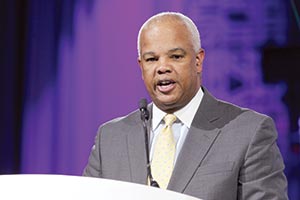Senior Reporter
Scott Darling: Driver Training, Clearinghouse Rules Close

This story appears in the Oct. 10 print edition of Transport Topics.
LAS VEGAS — The final rules for minimum entry-level driver training requirements as well as a drug-and-alcohol clearinghouse are being reviewed by the Office of Management and Budget. They are expected to be published in the Federal Register by the end of the year, the head of the Federal Motor Carrier Safety Administration said.
Scott Darling, administrator of FMCSA, also called for comments on a proposed rule requiring installation of speed limiters as the agency weighs whether to require heavy-truck speeds be limited to 60, 65 or 68 miles per hour.
He made the comments here Oct. 3 in an address to American Trucking Associations’ Management Conference & Exhibition.
MCE PHOTO GALLERY: Best pictures from Las Vegas
COMPLETE MCE COVERAGE: Live stories, photos, video, social media and more
“The driver training rule is an important step toward ensuring that all drivers are qualified and that training schools have the appropriate requirements in place,” Darling said.
He said the clearinghouse rule will help ensure that truck drivers remain free of drugs and alcohol.
“The rulemaking goes a long way towards that goal,” Darling said.
FMCSA published a proposed version of the entry-level driver rule in March after going through a negotiated rulemaking process with major industry stakeholders, including ATA, the Owner-Operator Independent Drivers Association, driver training schools and safety advocacy groups.
The proposed rule for a drug-and-alcohol clearinghouse, published in February 2014, requires motor carriers and other medical personnel to “report verifi ed positive, adulterated and substituted drug test results, positive alcohol test results, test refusals, negative return-to-duty test results and information on follow-up testing.” It also called for employers to annually search the clearinghouse for positive drug-and-alcohol test results and refusals to test for current employees as well as part of the pre employment process for prospective employees.
Darling also encouraged truckers to comment on a proposed rule requiring that speed limiters be installed on all new trucks, adding that the agency has been partnering with stakeholders who have a direct role in highway safety.
“We have reached out to partners in every segment of the industry. Whether you’re a big carrier, an ELD or truck manufacturer, shipper, broker or software developer, you have a direct role to play in highway safety,” Darling said. “We push safety partnerships because the stakes are high.”
Darling told truck executives that he was “disheartened” to learn of an increase in truck-involved fatalities in 2015.
He was referring to news in August that there were 4,067 fatalities in crashes involving large trucks in 2015, 4.1% more than in 2014, the highest since 2008, according to the Department of Transportation’s National Highway Traffic Safety Administration data.
“Those are not just mere numbers on paper, but each of them represents a human life lost on the highway,” Darling said. “We must do better.”

